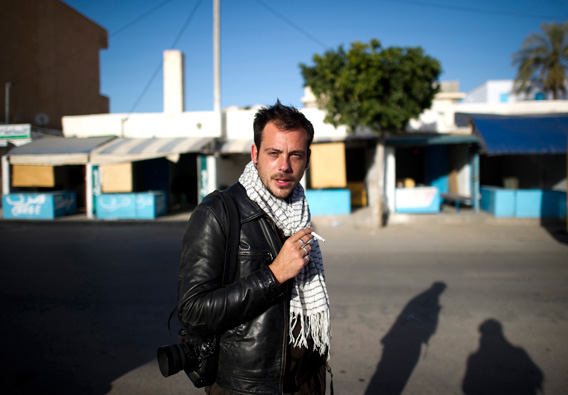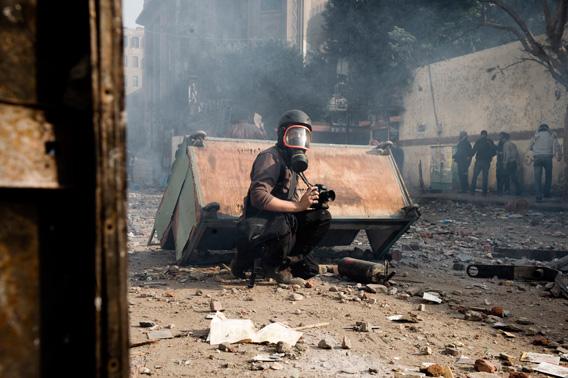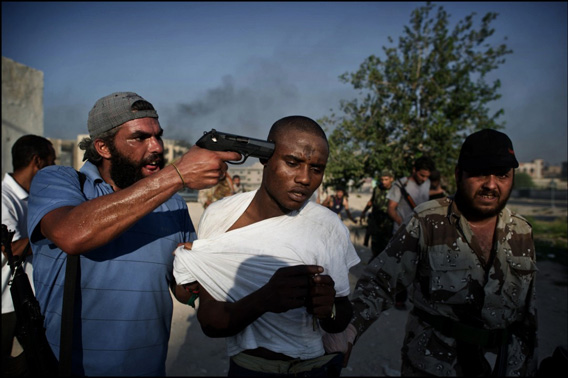A Young Photographer Who Refused to Give Up

Two weeks ago, 28-year-old French photographer Rémi Ochlik received one of the most significant awards in the world of photojournalism: first prize in the general news category of the World Press Photo contest. This is impressive for anyone, but for someone so young it’s exceptional. Even beyond the photo world, the final image in his winning story should be recognizable: a dead Muammar Qaddafi, lying pale and shirtless on a bloody mattress, surrounded by feet. (You can see that photo, and the others in his winning entry, in the gallery below.)
Now, along with veteran war reporter Marie Colvin, he has died, while covering another conflict, this time in Homs, Syria. Less than 24 hours after he’d arrived in the city, the two were killed by shelling just outside the makeshift press center. According to some reports, they were not simply caught amid conflict, but likely targeted as members of the media.
Too many young photographers and reporters have been taken from us too soon. Looking at Ochlik’s young face in the portrait accompanying his winning World Press entry, it occurred to me that the photographer who took it, Lucas Dolega, is also dead, killed last January, at age 32, while covering the uprising in Tunisia. Ochlik was devastated by his friend’s death, but felt it was important that he continued the work they had begun, as he told editors and reporters at the time. Rather then slow down, he pushed his way through the shifting epicenters of the Arab Spring, photographing revolution and violence in Tunisia and Egypt. He emerged from Libya, a conflict that killed the talented photojournalists Chris Hondros and Tim Hetherington, with award-winning photos and relatively unscathed.

His World Press Award did not leave him satisfied, but instead fueled a desire to do better, according to his colleague and friend Alfred de Montesquiou of Paris Match. And when that magazine told him that Syria was too dangerous, and refused to send him on assignment there, he returned the country on his own as a freelancer. He was determined to convey the despair of the Syrian people after 11 months of merciless repression, as Montesquiou explains in a heartbreaking homage to Ochlik, which led the magazine’s Web site Wednesday. “Above anything he wanted to make photos that left a mark,” Montesquiou writes.
“Remarkable” is how Aidan Sullivan, Chair of the 2012 World Press Photo Contest Jury, described the images. When I reached Sullivan, who is also Getty Images Vice President of Photo Assignments, he was shaken.
“I am deeply saddened by the tragic deaths of Marie Colvin and Rémi Ochlik who have been killed while covering events in Syria,” he wrote over email. He’d already lost Hondros, one of Getty’s best photographers this year. Now an up-and-comer had been killed, along with a veteran reporter he’d admired for decades. “In the 20 years since I’ve known Marie, she courageously covered conflict across the globe. She was an inspiration to all, totally dedicated, and it’s hard to believe she has gone.”

Sullivan was supposed to shake Ochlik’s hand at the awards ceremony in April. “His portfolio really stood out from the many that had been submitted and I regret that I will not have the chance to congratulate him.”
It feels strange to look through Ochlik’s Libya images now, seeing how narrowly he escaped the violence, only to fall victim to it a few months later. All 11 photos are arresting, but one in particular left me haunted. A rebel fighter points a gun to the head of an alleged pro-government mercenary, gripping him by his miraculously still-white shirt. The other rebel fighter holds him tightly, a bandaged hand attached to the waist of his enemy’s pants. They have all evidently been through a great deal, but this is the moment the tables turn. Every millimeter of the mercenary’s face spells defeat. It’s hard not to look at this man and feel sorrow that he’s about to die. But it’s impossible not to also feel excitement for the men who hold him, on the verge of victory over a crazy tyrant. It’s a complicated image for a complicated fight.
We don’t get these sorts of complicated images without photographers who can thrive on the edge.
Yesterday, a tribute to Ochlik and Colvin began making the rounds via Twitter: A video of Syrians in Homs risking more shelling to chant and sing. About half a minute in, a sign written in both English and Arabic fills the frame. “Rémi Ochlik. Marie Colvin. We will not forget you.”

